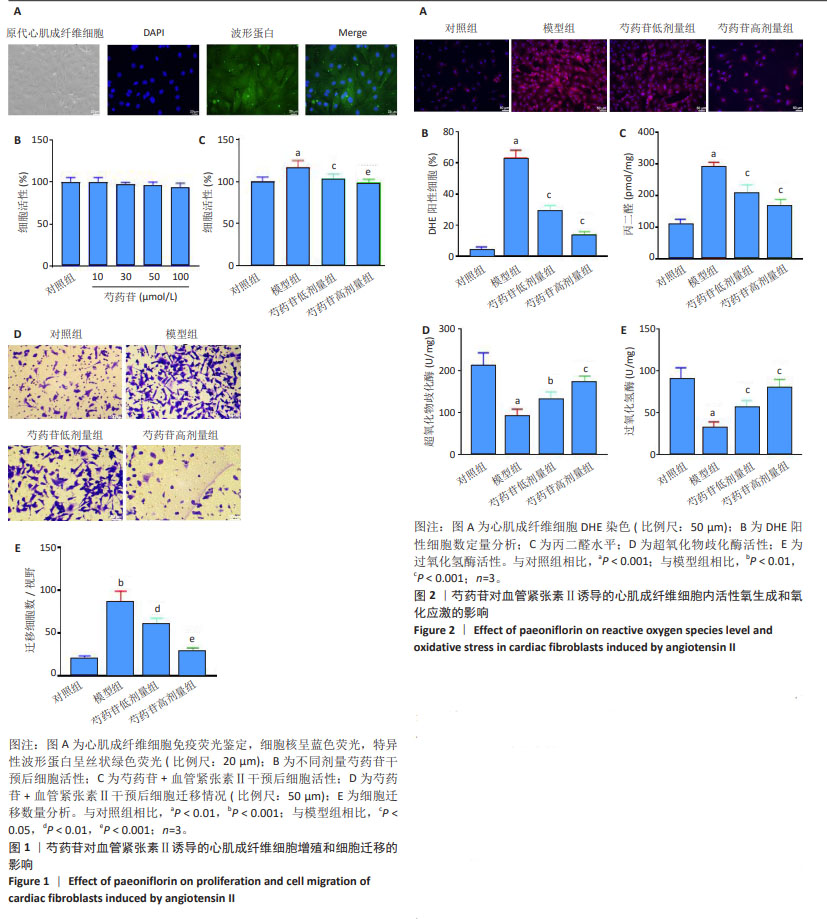[1] 谢君,符德玉,芦波,等.基于circRNA探讨中医药在心肌纤维化中的研究进展[J].中华中医药学刊,2022,40(3):134-138.
[2] ZHAO X, KWAN JYY, YIP K, et al. Targeting metabolic dysregulation for fibrosis therapy. Nat Rev Drug Discov. 2020;19(1):57-75.
[3] GAIDAI O, CAO Y, LOGINOV S. Global Cardiovascular Diseases Death Rate Prediction. Curr Probl Cardiol. 2023;48(5):101622.
[4] 姜伊雯,王耀晟.成纤维细胞骨架蛋白变化与心肌纤维化关联机制研究进展[J].上海医学,2023,46(12):854-858.
[5] LÓPEZ B, RAVASSA S, MORENO MU, et al. Diffuse myocardial fibrosis: mechanisms, diagnosis and therapeutic approaches. Nat Rev Cardiol. 2021;18(7):479-498.
[6] LIU M, LÓPEZ DE JUAN ABAD B, CHENG K. Cardiac fibrosis: Myofibroblast-mediated pathological regulation and drug delivery strategies. Adv Drug Deliv Rev. 2021;173:504-519.
[7] NAKANO T, KISHIMOTO H, TOKUMOTO M. Direct and indirect effects of fibroblast growth factor 23 on the heart. Front Endocrinol (Lausanne). 2023;14:1059179.
[8] BHULLAR SK, DHALLA NS. Angiotensin II-Induced Signal Transduction Mechanisms for Cardiac Hypertrophy. Cells. 2022;11(21):3336.
[9] LI CY, ZHANG JR, HU WN, et al. Atrial fibrosis underlying atrial fibrillation (Review). Int J Mol Med. 2021;47(3):9.
[10] XIAO Z, REDDY DPK, XUE C, et al. Profiling of miR-205/P4HA3 Following Angiotensin II-Induced Atrial Fibrosis: Implications for Atrial Fibrillation. Front Cardiovasc Med. 2021;8:609300.
[11] FRANGOGIANNIS NG. Cardiac fibrosis. Cardiovasc Res. 2021;117(6): 1450-1488.
[12] 张素华,栗志英,蔡安盛,等.双氢青蒿素对血管紧张素Ⅱ诱导的心肌成纤维细胞分泌胶原及激活PI3K/AKT通路的影响[J].中国实验诊断学,2024,28(4):483-485.
[13] 闫保娥,朱敏杰,方敏,等.姜黄素在心肌纤维化中的作用及机制研究进展[J].心脏杂志,2024,36(4):446-451.
[14] 尹茂山,牟艳玲. Sirt1与心肌保护[J].生命科学,2015,27(5):601-608.
[15] 闫景顺,朱林平,张红霞,等.中医药调控心肌纤维化相关信号通路研究进展[J].中国实验方剂学杂志,2024,30(13):230-239.
[16] 俞瀛.心房颤动住院患者的临床特征与中医证候要素规律分析[D].北京:北京中医药大学,2022.
[17] 黄文娟,熊丽辉.张锡纯治疗心悸辨证用药特色探析[J].吉林中医药,2012,32(1):83-84.
[18] 崔一然,唐仕欢,刘欣,等.基于数据挖掘的心悸伴失眠方证对应中成药用药规律分析[J].中华中医药杂志,2015,30(5):1792-1799.
[19] 侯明桥,张春媛,邱玲.参松养心胶囊联合美托洛尔治疗老年冠心病心律失常患者的效果观察[J].疑难病杂志,2015,14(5):508-510.
[20] 张璨,林鹏,杨玉,等.芍药苷抗肿瘤作用机制的研究进展[J].癌变·畸变·突变,2024,36(2):164-167.
[21] REN S, WANG Y, ZHANG Y, et al. Paeoniflorin alleviates AngII-induced cardiac hypertrophy in H9c2 cells by regulating oxidative stress and Nrf2 signaling pathway. Biomed Pharmacother. 2023;165:115253.
[22] LIU Y, HE CY, YANG XM, et al. Paeoniflorin Coordinates Macrophage Polarization and Mitigates Liver Inflammation and Fibrogenesis by Targeting the NF-[Formula: see text]B/HIF-1α Pathway in CCl4-Induced Liver Fibrosis. Am J Chin Med. 2023;51(5):1249-1267.
[23] 王东轶.芍药苷脂质体调节巨噬细胞极化对类风湿关节炎滑膜炎症的作用和机制研究[D].南京:南京中医药大学,2022.
[24] MA Y, LANG X, YANG Q, et al. Paeoniflorin promotes intestinal stem cell-mediated epithelial regeneration and repair via PI3K-AKT-mTOR signalling in ulcerative colitis. Int Immunopharmacol. 2023;119:110247.
[25] WU J, ZHANG D, HU L, et al. Paeoniflorin alleviates NG-nitro-L-arginine methyl ester (L-NAME)-induced gestational hypertension and upregulates silent information regulator 2 related enzyme 1 (SIRT1) to reduce H2O2-induced endothelial cell damage. Bioengineered. 2022;13(2):2248-2258.
[26] ZENG K, XI W, QIAO Y, et al. Paeoniflorin inhibits epithelial mesenchymal transformation and oxidative damage of lens epithelial cells in diabetic cataract via sirtuin 1 upregulation. Bioengineered. 2022;13(3): 5903-5914.
[27] 何婷,陈军,庞牧,等.TGF-β1/Smads信号通路在SIRT1抗心肌纤维化中的作用及机制研究[J].华中科技大学学报(医学版),2024, 53(1):45-51.
[28] WANG AJ, TANG Y, ZHANG J, et al. Cardiac SIRT1 ameliorates doxorubicin-induced cardiotoxicity by targeting sestrin 2. Redox Biol. 2022;52:102310.
[29] 孙韬,宋爽,陈磊,等.芍药苷对TGF-β1诱导的HK-2细胞纤维化及PI3K/AKT通路的影响[J].河南医学高等专科学校学报,2023, 35(6):611-616.
[30] 王甜甜,王魏,杨翠华,等.大黄酸对高糖诱导的H9c2心肌细胞损伤的保护作用及机制[J].中西医结合心脑血管病杂志,2024, 22(3):459-463.
[31] PFAFFL MW. A new mathematical model for relative quantification in real-time RT-PCR. Nucleic Acids Res. 2001;29(9):e45.
[32] 尚茹茹,童曼琳,刘晓红.高良姜素减轻异丙肾上腺素诱导心脏纤维化的作用机制[J].中西医结合心脑血管病杂志,2023,21(24): 4524-4529.
[33] REN C, ZHAO X, LIU K, et al. Research progress of natural medicine Astragalus mongholicus Bunge in treatment of myocardial fibrosis. J Ethnopharmacol. 2023;305:116128.
[34] 赵世杰,王文荣,王婧一,等.芍药苷对单侧输尿管梗阻大鼠肾间质纤维化的作用[J].中国中西医结合肾病杂志,2018,19(11):985-987.
[35] 江舜祥,涂彬,宋凯,等.过表达sFRP3对小鼠原代心肌成纤维细胞活化增殖的影响[J].安徽医科大学学报,2024,59(5):809-814.
[36] 帅壮,唐锴,刘茂,等.加入芍药苷的乳鼠心脏成纤维细胞增殖、凋亡、纤维化及TGF-β1 mRNA和Smad3 mRNA表达观察[J].山东医药, 2020,60(18):40-43.
[37] VALIENTE-ALANDI I, SCHAFER AE, BLAXALL BC. Extracellular matrix-mediated cellular communication in the heart. J Mol Cell Cardiol. 2016;91:228-237.
[38] ZHANG Y, YANG X, HAN C, et al. Paeoniflorin-6’O-benzene sulfonate suppresses fibroblast-like synoviocytes proliferation and migration in rheumatoid arthritis through regulating GRK2-Gβγ interaction. Exp Ther Med. 2022;24(2):523.
[39] KHOSRAVI M, POURSALEH A, GHASEMPOUR G, et al. The effects of oxidative stress on the development of atherosclerosis. Biol Chem. 2019;400(6):711-732.
[40] NEUMAN RB, BLOOM HL, SHUKRULLAH I, et al. Oxidative stress markers are associated with persistent atrial fibrillation. Clin Chem. 2007;53(9): 1652-1657.
[41] AN D, ZENG Q, ZHANG P, et al. Alpha-ketoglutarate ameliorates pressure overload-induced chronic cardiac dysfunction in mice. Redox Biol. 2021;46:102088.
[42] 王健康,王彬,郭家娟.基于氧化应激探究中医药防治心肌纤维化的研究进展[J].中西医结合心脑血管病杂志,2024,22(7): 1256-1261.
[43] JANUARY CT, WANN LS, ALPERT JS, et al. 2014 AHA/ACC/HRS guideline for the management of patients with atrial fibrillation: a report of the American College of Cardiology/American Heart Association Task Force on practice guidelines and the Heart Rhythm Society. Circulation. 2014;130(23):e199-267.
[44] HAN F, ZHOU D, YIN X, et al. Paeoniflorin protects diabetic mice against myocardial ischemic injury via the transient receptor potential vanilloid 1/calcitonin gene-related peptide pathway. Cell Biosci. 2016;6:37.
[45] 李雪,赵雅静,张芹,等.心肌纤维化调控机制的研究进展[J].中国医药,2024,19(2):285-288.
[46] 王海强,黄耀添,赵黎,等. 张应力对深筋膜Ⅰ、Ⅲ型胶原影响的实验研究[J].中国临床康复,2002,6(2):208-209.
[47] 赵倩茹,曹梦菲,孙侠,等.Yes相关蛋白在血管紧张素Ⅱ诱导的心肌纤维化中的作用及机制研究[J].中华老年心脑血管病杂志, 2022,24(3):306-310.
[48] 刘旺,周琴怡,莫志勇,等.SIRT1调控氧化应激的研究进展[J].中南医学科学杂志,2021,49(2):239-243. |

